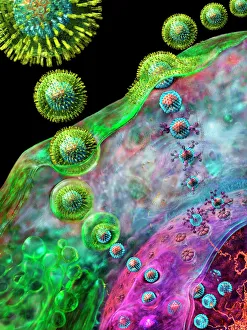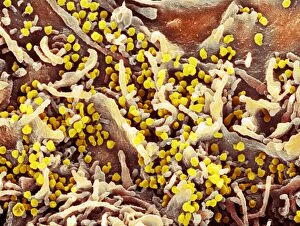Herpesviridae Collection
Herpesviridae, a family of viruses that includes the notorious herpes virus, is known for its ability to replicate and cause infections in humans
All Professionally Made to Order for Quick Shipping
Herpesviridae, a family of viruses that includes the notorious herpes virus, is known for its ability to replicate and cause infections in humans. With their unique structure and complex life cycle, these viruses have been extensively studied and depicted through computer artwork. In one captivating image, we witness the replication process of the herpes virus. Multiple particles are seen emerging from an infected cell, highlighting the rapid spread of this infectious agent within our bodies. The intricate details captured by this artwork showcase the complexity of viral replication. Another striking depiction showcases a single herpes virus particle in stunning detail. This computer-generated image allows us to appreciate the symmetrical shape and distinct features of these tiny entities responsible for causing such widespread infections. Microscopic views further emphasize the microscopic world where these viruses thrive. Through high-resolution imaging techniques, scientists have captured mesmerizing images revealing the intricate structure of herpesviruses. These close-ups provide valuable insights into their morphology and help researchers better understand how they interact with host cells. Amongst them is a conceptual image portraying human cytomegalovirus – a member family that can lead to severe complications in immunocompromised individuals. This visual representation serves as a reminder of how impactful these viruses can be on human health. As we delve deeper into microscopy studies, multiple microscopic views present themselves - each showcasing different aspects of herpesvirus structures. These images not only captivate our imagination but also highlight just how diverse and adaptable these viral particles can be. Finally, an artistic rendition portrays a ubiquitous virus conceptually linked to Herpesviridae family – emphasizing their omnipresence across various environments worldwide. It reminds us that despite being infamous for causing diseases like cold sores or genital lesions, members within this viral family exist beyond human hosts too. Through captivating computer artwork and microscopic imagery alike, we gain glimpses into the fascinating world - unveiling both their beauty and their potential to wreak havoc on human health.














